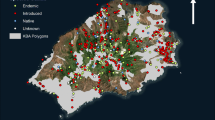Abstract
Selection of informative focal groups is an important avenue to increasing the applications of invertebrates in conservation assessments and inventory studies, and to help overcome the challenges of high diversity, all-taxon surveys and taxonomic inadequacy. Spiders are a possible focal group of wide relevance in terrestrial ecosystems, but considerable further work is needed to clarify their broad values as indicators, the relevance of higher taxon surrogacy, the taxonomy of selected families and genera, and to develop standard sampling protocols. The current values of spiders in conservation asessment, and the prospects of enhancing their value as a focal group are enumerated and discussed.
Similar content being viewed by others
References
Andersen, A.N. (1990) The use of ant communities to evaluate environmental change in Australian terrestrial ecosystems: a review and a recipe. Proc. Ecol. Soc. Aust. 16, 347–57.
Andersen, A.N. (1997) Functional groups and pattern of organisation in North American ant communities: a comparison with Australia. J. Biogeog. 24, 433–60.
Basset, Y. (1995) The taxonomic composition of the arthropod fauna associated with an Australian rainforest tree. Aust. J. Zool. 39, 171–90.
Churchill, T.B. (1995) Scales of spatial and temporal variation in a Tasmanian heathland spider community. Ph.D. thesis, Griffith University, Brisbane.
Churchill, T.B. (1997) Spiders as ecological indicators: an overview for Australia, Memoirs of the Museum of Victoria 56, 331–7.
Coddington, J.A., Griswold, C.E., Davila, D.S., Penagranda, E. and Larcher, E.F. (1991) Designing and testing sampling protocols to estimate biodiversity in tropical ecosystems. In The unity of evolutionary biology (E.C. Dudley, ed.), pp. 44–60. Portland: Dioscorides Press.
Coddington, J.A., Young, L.H. and Coyle, F.A. (1996) Estimating spider species richness in a southern Appalachian cove hardwood forest. J. Arach. 24, 111–28.
Danks, H.V. (1996) How to assess insect diversity without wasting your time. Biological Survey of Canada (Terrestrial Arthropods). Document series No 5, Ottawa.
Davies, V.T. (1985) Arachnida. Araneomorphae (in part). Zool. Cat. Aust. 3, 49–125.
Dobyns, J.R. (1997) Effects of sampling intensity on the collection of spider (Araneae) species and the estimation of species richness. Envir. Entomol. 26, 150–62.
Edwards, R.L. (1993) Can the species richness of spiders be determined? Psyche 100, 185–208.
Eyre, M.D. and Woodward, J. (1996) Spiders in environmental surveillance and site assessment. In Environmental monitoring, surveillance and conservation using invertebrates (M.D. Eyre, ed.), pp. 26–8. Newcastle: EMS publications.
Greenslade, P.J.M. (1979) A guide to ants of South Australia. South Australian Museum, Adelaide.
Humphreys, W.F. (1988) The ecology of spiders with special reference to Australia. In Australian Arachnology (A.D. Austin and N.W. Heather, eds), pp. 1–22. Brisbane: Australian Entomological Society Misc. Publn. 5.
Maelfait, J.-P., Desender, K. and Baert, L. (1989) Some examples of the practical use of spiders and carabid beetles as ecological indicators. Proceedings of the symposium ‘Invertebrates of Belgium’, Brussels, 437–42.
Main, B.Y. (1987) Ecological disturbance and the conservation of spiders: implications for biogeographic relics in southwestern Australia. In The role of invertebrates in conservation and biological survey (J.D. Majer, ed.), pp. 89–97. Perth: West Australian Department of Conservation & Land Management.
Marc, P. and Canard, A. (1997) Maintaining spider diversity in agroecosystems as a tool in pest control. Agri., Ecosys., Envir. 62, 229–35.
Mawson, P.R. (1986) A comparative study of arachnid communities in rehabilitated bauxite mines. West Australian Institute of Technology, School of Biology, Bulletin no 14.
New, T.R. (1993) Angels on a pin: dimensions of the crisis in invertebrate conservation. Amer. Zool. 33, 623–30.
New, T.R. (1994) Conservation assessment of invertebrate assemblages: is there a place for global level taxonfocusing? Memoirs of the Queensland Museum 36, 153–7.
New, T.R. (1995) Introduction to invertebrate conservation biology. Oxford: Oxford University Press.
New, T.R (1998) Invertebrate surveys for conservation. Oxford: Oxford University Press.
New, T.R (1999) Descriptive taxonomy as a facilitating discipline in invertebrate conservation. Transac. Royal Zool. Soc. New South Wales 154–8.
Nyffeler, M., Sterling, W.L. and Dean, D.A. (1994) How spiders make a living. Envir. Entomol. 23, 1357–67.
Raven, R.J. (1988) The current state of Australian spider systematics. In Australian Arachnology (A.D. Austin and N.W. Heather, eds), pp. 37–47. Brisbane: Australian Entomological Society Misc. Publn. 5.
Samu, F. and Lovei, G.L. (1995) Species richness of a spider community (Araneae): extrapolation from simulated increasing sampling effort. Eur. J. Entomol. 92, 633–8.
Speight, M.C.D. (1986) Criteria for the selection of insects to be used as bioindicators in nature conservation research. Proceedings of the 3rd European Congress of Entomology, Part 3, 485–488, Amsterdam.
Thornton, I.W.B. and New, T.R. (1988) Krakatau invertebrates: the 1980s fauna in the context of a century of recolonisation. Philosophical Transactions of the Royal Society of London, B 322, 493–522.
Topping, C.J. and Lovei, G.L. (1997) Spider density and diversity in relation to disturbance in agroecosystems in New Zealand, with a comparison to England. N.Z. J. Ecol. 21, 121–8.
Topping, C.J. and Sunderland, K.D. (1994) Methods for quantifying spider density and migration in cereal crops. Bull. Br. Arach. Soc. 9, 209–13.
Turner, M. and Polis, G.A. (1979) Patterns of coexistence in a guild of raptorial spiders. J. Anim. Ecol. 48: 509–20.
Yen, A.L. (1995) Australian spiders: an opportunity for conservation. Records of the Western Australian Museum, Supplement 52, 39–47.
Yen, A.L. and Butcher, R.J. (1997) An overview of the conservation of non-marine invertebrates in Australia. Canberra: Environment Australia.
Author information
Authors and Affiliations
Rights and permissions
About this article
Cite this article
New, T. Untangling the Web: Spiders and the Challenges of Invertebrate Conservation. Journal of Insect Conservation 3, 251–256 (1999). https://doi.org/10.1023/A:1009697104759
Issue Date:
DOI: https://doi.org/10.1023/A:1009697104759




